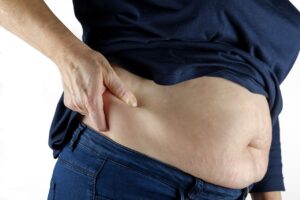What is estrogen?
Estrogens are not just one hormone, but three types of hormones that can change into each other in the body. The most important role of estrogen is the development of secondary female sexual characteristics and the regulation of the menstrual cycle. The role of estrogens during pregnancy is less well understood, but they are thought to play a key role in the development of fetal organs.
What compound is estrogen?
Estrogens are steroid hormones produced in the ovaries, placenta and testes. The word “steroid” refers to their sterol skeleton (progesterone, testosterone or adrenal hormones are also steroid hormones). The three main types of estrogens are estrone, estradiol and estriol. In sexually mature women who are not pregnant, oestradiol plays the most important role, oestrone becomes more important after menopause and oestriol become more important during pregnancy.
Where is estrogen produced?
Estrogens are mainly produced in the ovaries and adrenal glands, which are broken down and metabolised by the liver into conjugated estrogen. From there it is released into the bile and excreted through the intestines. It is also produced in the placenta and, to a lesser extent, in the corpus luteum.
However, at lower concentrations, other tissues such as the liver, adrenal glands and breast cells also produce estrogens. These are secondary sources of estrogen in the body. This is especially important in the post-menopausal period when the female body’s production of oestrogen decreases.
It is known that fat cells can also produce estrogens, which could be one of the possible reasons why both obesity and malnutrition increase the risk of infertility.
Estrogen in men
Estrogens are primarily female sex hormones but are also found in smaller amounts in men (for example, they play an important role in the maturation of male germ cells). Estrogens are not only involved in the development of the secondary female sex characteristics but also other processes related to the development of the body, such as the maturation and growth of the long bones. Estrogen deficiency may therefore be associated with the development of osteoporosis after menopause.

How does estrogen work?
Estrogens, like all steroid hormones, can cross the cell barrier immediately. Once inside the cell, they bind to receptors (signalling molecules that can sense the hormone), which increases the activity of certain genes.
The relationship between the digestive system and estrogen
Ideally, 99% of good bacteria are present in the microbiome, a condition called eubiosis. Due to diet, antibiotics, xenobiotics and many harmful environmental factors, an imbalance called dysbiosis is common.
The gut microbiome plays a crucial role in regulating circulating levels of oestrogen. Certain microbes in the microbiome, called estrobolome bacteria, are involved in regulating estrogen levels.
Estrobolome produces an enzyme called β-glucuronidase, which deconjugates estrogens. These affect the number of estrogens that can be reabsorbed and bind to the body’s estrogen receptors. In this way, they influence the physiological processes that regulate hormones.

Estrogen deficiency or excess
The microbiome plays a key role in the detoxification of estrogen. When there is plenty of β-glucuronidase produced in the gut, oestrogen homeostasis is maintained. In dysbiosis, β-glucuronidase production is up- or down-regulated by oestrobolomas, resulting in oestrogen deficiency or excessive levels of oestrogen in the body.
Dysbiosis of the gut most commonly leads to excess estrogen in the body.
In a healthy microbiome, the intestinal bacterium estrobolome minimises the absorption of estrogen from the gut so that it can be safely excreted in the stool and urine. This ensures hormone balance.
Breast cancer in postmenopausal women has recently become a public health concern. It is a malignant disease that beneficial bacteria may be able to compete against.
Clinical studies have shown that inulin, a non-digestible carbohydrate in the diet, inhibits tumour development. Eating inulin is risk-free and can easily be used in cancer therapy. The anti-cancer effect is due to the oestrogen-degrading action of the enzyme beta-glucuronidase produced by the lactobacilli.
Fulvicherb – Synergy contains inulin and therefore has a positive effect on the composition of the intestinal flora. If you need more inulin, our product Fulvicherb – Apple Pectin with inulin is also available.
The role of short-chain fatty acids
The metabolites that are produced as a result of the interaction between the host and the microbiome play a very important and irreplaceable role in the body. Short-chain fatty acids (SCFA), branched short-chain fatty acids (BSCFA), branched-chain fatty acids (BCFA), secondary bile acids and tryptophan-derived metabolites play a very important role in the balance of the body.
These fatty acids are formed in the intestine at the right rate and in the right quantity through the ingestion of fermentable dietary fibre and thus indirectly ensure the hormonal balance of the body.
Read the article in German: Die Verbindung zwischen Verdauung und Östrogen (Estrogen)
Read the article in Polish: Związek między układem pokarmowym a estrogenem





